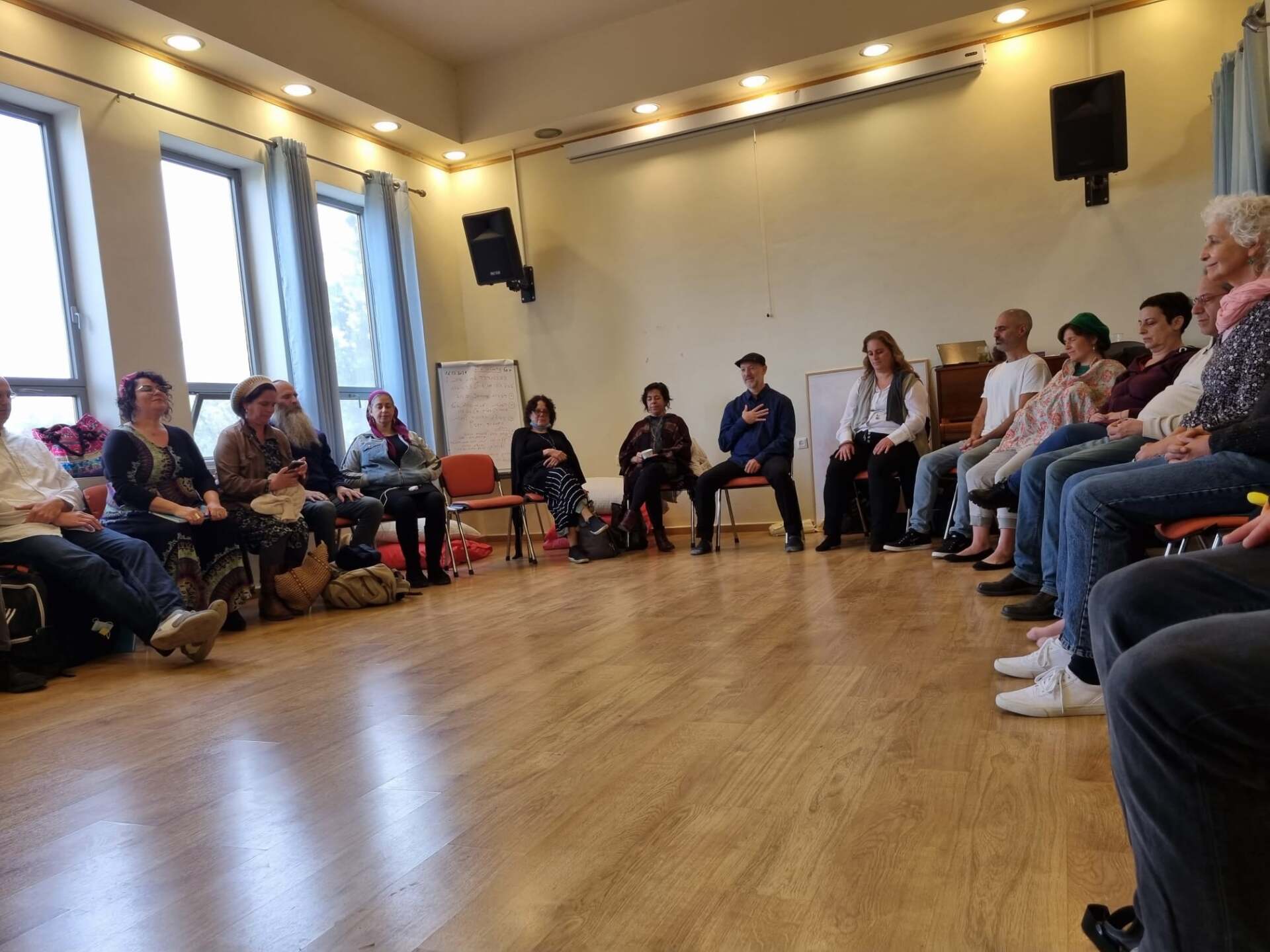Blog

Welcome to our Online Workshop, Healing Communication ! This workshop aims to provide you with tools, insights, and practices to enhance emotional and somatic intimacy, authentic communication, personal and relationship development. The event will feature two relationship experts from the USA and Europe, offering methods to foster aligned relationships, through exploring various teachings, interactive exercises, meditations, and more. During the workshop we will explore 3 main topics: Identifying Various Relationship Dynamics. Exploring and understanding different dynamics and the effect on the body breathing patterns, state of mind, energy and soul. Recognize & Improve Awareness of Past and Current Wounds. Discussions and practices aimed at resolving past traumas, toxic patterns, and emotional baggage that affect current relationships. 7 Stages of Aligned Relationships Powerful tools for improving our ability for a healthy and sustainable relationship with exercises focusing on each of the 7 embodied energy centers. By attending this workshop, you will learn: Relationship Dynamics Awareness- Techniques to identify and shift unhelpful patterns in relationships Healing Practices for Emotional Wounds- Guided exercises to release past traumas, reduce emotional reactivity, and foster inner peace. The 7 Stages of Alignment Toolkit- Learn tools for sustainable partnerships through exercises focused on seven energy centers. The workshop is designed for Singles, Couples,Therapists, Coaches and anyone interested in personal growth within the context of relationships. Looking forward to see you on the 16 February 2025, Liat & Gabriel

Magic happens when 36 couple therapists (a number considered lucky in Judaism) meet during a full day in Neve Shalom, for a conference - professional training and a captivating encounter of professionals (couple therapists, individual therapists, trainers and teachers) from the field of body and mind psychotherapy. It creates a profound connection between all the participants, and at every level. And that was exactly the feeling at the Spiritual Centre in Neve Shalom, a sense of connection, togetherness, and community - a feeling that transcends words. A huge and deep thank-you to everyone who took part (a relatively good proportion for a therapists’ event ... between male and female - 14 men and 22 women). Thanks to Tal Hakim, Yael Chen Yemini, and Shachar Erez for their fascinating lectures which left us all longing for more, and a big thank you to Yotam for his major assistance in creating the meeting and to his partner - the lovely Kai, who handled yesterday's wonderful culinary aspect. And I’m deeply grateful... for this was one of the most exciting and meaningful encounters I have ever experienced. Wishing health, happiness, love to us all 💙 Gabriel

After a long year of Corona, with some concerns that it’s still here, and not leaving us so quickly ... I find myself having many thoughts, reflections, and feelings about the transitions I experienced this year – from Zoom sessions, to sessions with physical-body-presence. Last Thursday, July 1, I had two exciting and interesting live, physical meetings... in Tel Aviv. A lunchtime training session for participants from Israel, from an international couple therapy course via Zoom - Naama, Gideon, Dina, Yonatan, Erenssa, and Ruthi (six out of 24 participants from eleven countries). Then in the evening professional training for therapists, at the Lighthouse Centre, sponsored by the Israeli Body Psychotherapy Association, on ‘Couple Resonance in Couple & Individual Therapy’. I really enjoyed and was thrilled by those two non-Zoom encounters ... ⭐Since March 2020, we all grew accustomed to zigzagging between Zoom sessions and to clinic sessions. ⭐ Over that year, I taught and trained 22 first-year students at Reidman College, helped by three wonderful assistants - Ziva, Shirel and Sylvina. At first our classes were via Zoom, then in three rooms in a hybrid way, and now to everyone’s joy, in Semester 2 we’re back to one classroom in the college. ⭐ ⭐At Haifa University, it’s been an exciting and meaningful year, with much of the training happening at the Hakomi Centre (many thanks to Keren and Ido Tsarfati), for the seven outstanding students who graduated the master’s degree in the Mind-Body Psychotherapy track, and facilitating a Somatic Psychotherapy course, over Zoom, for second-year students. ⭐That transition from Zoom sessions, to whole and physically present body sessions, let us grow and develop further. We were able to fine-tune our personal and professional abilities as people, therapists, and teachers in a fascinating field of therapy, and a wonderful way of life – body psychotherapy 🔥 ⭐ Now freedom is just around the corner - really close. Next week is the end of a two-day course in Neveh Shalom with first year body psychotherapy students at Reidman College, and further professional training for therapists world-wide (in English, via Zoom) – the Secrets workshop on July 11. 💎 Wishing us all great July-August holidays 🙏 health, happiness, and love 💙 – and a wonderful day, Gabriel

After a highly challenging and complex year, a new school year will begin soon. It brings with it new kinds of excitement alongside concerns about Zoom and Covid, all familiar options for me. Despite them and our complex current situation – I’m happy to resume teaching. Starting next week i will be teaching at: Haifa University in the master's degree track, specializing in integrative body-mind-spirit psychotherapy, in the second and third years. On 5 November 5 a training course is set to start, training therapists in couple therapy using Body Psychotherapy. It will be given in English, via Zoom, and twenty therapists from nine countries will participate. From mid-November, at Reidman College, this year I’ll be accompanying first-year students in the Body Psychotherapy track. At the start of every year, there are always so many expectations and curiosity about working together with students and therapists in their learning, training, personal and professional development process. This year, more than ever, we’ll be needing lots of strength, flexibility, creativity, and belief. I’d like to wish good luck and a captivating school-year to all the students, lecturers, colleagues, and friends in the field. Have a wonderful year 🙏 Gabriel

what’s happening to all of us, myself included, with the second lockdown that’s starting very soon in Israel, is very interesting and challenging. Conversations with a range of people - patients, therapists, couples, and trainees – showed me that while concerns about the coming days exist, this time they are less powerful. We’ve become accustomed to integrating work in the clinic with sessions over Zoom. An inner flexibility has formed in us, and it’s helped to build a sense of confidence. Cognitive and inner flexibility, I believe, helps to create a place of confidence that we project out to our patients. It’s a complex, but truly interesting period within the mental processes that we are working with. This is a period which profoundly touches on our existential uncertainty and in the days ahead it can help with our personal development and that of our patients. I’ve found that, now and then, leaving the clinic and the chair in front of the computer and Zoom, and moving to the two chairs facing the olive tree and practicing mindfulness breathing, together with patients for whom it’s suitable, is an excellent resource for therapist, patient, and the therapeutic relationship. This is a good time to wish you Shanah Tovah, (Jewish new year) and may it be for all of us a year of confidence, flexibility, health and lots of love. Have a great day! Gabriel.

When the Covid-19 pandemic erupted, we all became Zoom therapists at short notice. We had to encompass and support our clients and be there for them. This period is presenting everyone with many emotional and psychological challenges. In fact though, even after Covid-19 comes to an end, Zoom therapy and online therapy are likely to remain with us. For the past four years I’ve gained experience in online therapy using Skype, with clients overseas and/or in Israel who live far from my clinic. From that experience, and because of the intensiveness of therapy sessions at the present time, I’ve noticed that resonating experiences at the physical, energetic, and breathing level has become a vital resource for the therapist. It helps to create and preserve a deep therapeutic relationship, despite the distance and the computer-screen dividing us. How should we integrate the body psychotherapy sphere with awareness to the body - emotions - spirit - breathing connection in Zoom therapy? In the past few months our clinics have made the transition to remote therapy via Zoom. Those who did not previously provide therapy online - and even those who did – are now coping with long hours and continuous days of computer therapy. As therapists our task is not only to get organised and adapt ourselves, but also to modify our therapy and to examine in depth the significance of remote therapy, and the unique qualities of this approach. At further training courses for therapists and coaching therapist I’m now focusing on questions and issues connected to online therapy, and body psychotherapy through Zoom. Among others, I’m teaching and training therapists in: how to create a profound therapeutic relationship through the computer screen , and how to overcome the lack of physical connection; how to cope with the transference and countertransference that’s unique to Zoom therapy; creating a special setting, and a sense of security and trust ; supportive treatment in crisis situations , with breathing and movement exercises; physical and mental feelings and resonance from both sides of the screen; what happens to the therapist-client encounter at the energetic level and other levels; how to work with the body and breathing in long-distance therapy ; working with movement in the therapeutic space via Zoom or Skype – can it be done? how to work with Zoom couple therapy , with two or three screens. I invite therapists to follow me on Facebook to keep up-to-date with workshops and further training for therapists.The body content of your post is here. To edit this text, click on it and delete this default text and start typing your own or pasting your own from another source.

‘Sarah and David are sitting opposite me. Their chairs are at some distance from each other, and turned towards me. They hardly look at each other, and avoid it by maintaining eye contact with me. It’s our first meeting, and the tension is tangible in every sense of the word. It’s a familiar situation when couple therapy begins, and it stems from preliminary embarrassment and normative difficulty in starting therapy. During the initial conversation I listen to them, and simultaneously try to feel the energy and atmosphere in the room. I turn inwards to myself, sense my own body and breathing. I resonate myself and them. The room feels congested. Rigid. There’s a heaviness. The atmosphere is distant and I have a feeling of coldness. I notice that there’s no breathing within the room. Neither of them are breathing and this affects my breathing which halts as well. Out of awareness and in resonance, I enlist myself to breathe deeply despite the tension. I reflect to the couple: “There’s a lot of tension in the room”, then I breathe deeply again, which allows Sarah and David to breathe as well, to release some of their difficulty and start talking about what’s really in their hearts’. This is the first paragraph of my most recent article - Melting the Couple Armour in Body Psychotherapy for Couples . So what exactly is body armour? Through my clinical work for over 20 years, providing individual and couple body psychotherapy, I’ve seen that the personal armour process is widening. It’s now also found in couples - where it’s more complex. Just as each of us has held-back, rigid, tensed places, in the same way during every in-depth encounter between two people difficulties are created between them at all levels: impaired communication, lack of confidence, a lack of intimacy, difficulties with sexuality, an encounter that creates complexity, pain, difficulties. All of them build the ‘couple armour’. When the burdens of life and personal difficulties intensify, in a natural and normal way, we can sense in the couple relationship that the problems are increasing at every level. One can sense emotional, energetic, emotional, physical and respiratory difficulties in each member of the couple and jointly - where the couple armour is built. Working with couple armour in couple body psychotherapy In individual and couple body psychotherapy, the therapist sees in front of him three entities - the two members of the couple, and their relationship itself. When observing deeply, and profoundly resonating across from the couple, we can see and feel the couple armour in energetic terms – the energetic armour. While couple armour resembles individual armour, it is broader because it encompasses the two partners and their reciprocal dynamic. Our capacity as couple therapists to sense and observe couple armour in parallel with the primary personality is very helpful in the therapeutic process by being present with the relationship and couple dynamic. The aim is to observe and reflect, to help create the optimum process for the couple dynamic, the couple relationship and in other words – for the process of melting the couple armour. For further reading on couple armour and the process of melting it with body psychotherapy for couples, I invite you to read my latest article published in SPT - Somatic Psychotherapy Today in January 2020.

Each couple therapy process starts with a certain difficulty – a crisis for the couple, or a real crossroads – over the question whether to separate or to stay together - and how? When a couple comes to therapy in the clinic it’s usually following an accumulation of difficulties. It’s been going on for quite a while, and maybe it took time until they realised the need for therapy. Sometimes once partner pushes for it and the other agrees. It can result from a specific crisis, from an obvious trigger like a crisis of trust, betrayal, financial difficulties or problems with the children. In many cases though, it’s a bit of everything - life, routine, career, personal fulfilment, life- and age-transitions, the children, the couple’s parents, their financial situation, sexuality and desire, and of course – each one’s behaviour patterns, and communication difficulties stemming from differences in character. For every difficulty that couples bring with them to the clinic - and it makes no difference which tensions, pressures, and crises are reflected in the armour surrounding them - I have the experience, belief, tools and confidence to help, to illuminate matters, to help the couple see more than their individual and couple difficulties and weaknesses. In the therapeutic process we use joint work to melt the armour (URL) and to gain access to what lies below: to what connects them, each partner’s qualities, resources and healing sources for their couple relationship. From that point, we’ll find a shared way for enhancement, connections, for love, and for better discourse. In every new couple-process, the connection between couple therapy and body psychotherapy is enriching, meaningful and exciting, and for over 15 years it’s been an important personal mission for me. I would like to invite you to learn about that connection through workshops and further study courses for therapists. And of course I invite you to a process of personal enhancement as therapists - to learn body psychotherapy for couples in a Zoom course opening in November 2020. It will be conducted in English, for a target population of therapists worldwide. A few words about the couple therapy course The course targets psychotherapists and therapists with experience from different spheres who are interested in working with couples and acquiring tools and know-how from the body psychotherapy world - techniques of awareness, conversation, movement, touch, and breathing. In a journey of experiential and theoretical learning, we’ll study the complexity of couple therapy, which requires encompassing ‘four people’ in the therapy room: the couple, the couple relationship, the therapist, and of course the referential ties between all of them. The learning process will give the individual therapist tools for coping and for couple therapy, together with personal enhancement and empowerment. This is the fifth session of the course for body psychotherapy therapists, and I’m grateful for the privilege to teach it again for students and therapists (and for other clients as well).

I sense my own body, the couple in front of me (each one separately), and I feel the couple relationship itself. I sense the breath, the sensations, the energy of what’s being said, and also what isn’t being expressed but is still sensed below the surface. Whether it’s anger, sadness, loneliness, yearning, or happiness, my role as therapist is, among others, to check what’s rising to the surface within me. How does it feel for me? And then to resonate it outwards to the couple in the therapeutic process. Sometimes resonance is expressed as simple recognition - in a word or phrase like “there’s so much heaviness in the room now”. In many cases it’s sufficient to make things easier, to bring about awareness, to introduce the couple’s breathing, and then enable a deeper exploration. Couple resonance Couple resonance is a major tool in couple therapy with body psychotherapy. Awareness to the deep resonance that exists between the members of a couple, and our ability as therapists to teach our clients to sense their partner profoundly, can create powerful intimacy and empower the relationship. Resonance is a useful tool that the couple take home with them - for their couple relationship, for life itself. From one session to the next, they see me resonating and learn to resonate themselves. This is so significant for them later, once they can feel their partner instead of making assumptions, can step for a moment into the partner’s shoes, become aware of the partner’s emotions instead of hurling accusations. I’m delighted to invite you to join a workshop for therapists on the topic of couple resonance. At the workshop, you’ll learn about resonance as a tool in couple therapy using body psychotherapy. We can implement the resonance tool as therapists, in individual or couple therapy, and we can certainly teach it and pass it on to others. The workshop will be held by Zoom on 23 July 2020. It’s an introductory workshop ahead of a longer in-depth course for couple therapy using body psychotherapy that will start this November on Zoom (in English). I’ll be happy to see you. Gabriel



